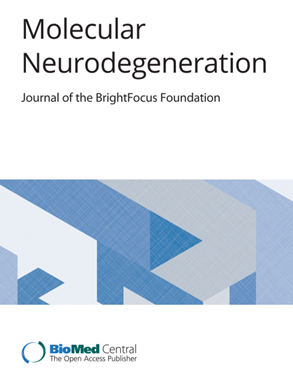Inactivation of NLRP3 inflammasome by dephosphorylation at Serine 658 alleviates glial inflammation in the mouse model of Parkinson’s disease
IF 17.5
1区 医学
Q1 NEUROSCIENCES
引用次数: 0
Abstract
Parkinson’s disease (PD) is a leading neurodegenerative disorder characterized by the progressive loss of dopaminergic neurons, contributing to considerable disability worldwide. Current treatments offer only symptomatic relief, highlighting the need for novel therapeutic strategies targeting disease progression. Neuroinflammation plays a pivotal role in PD pathogenesis, with the NLRP3 inflammasome emerging as a key contributor. The virtual screening of a natural product library comprising 5,088 compounds was applied to identify five potential NLRP3 inhibitors through molecular docking scores. Then surface plasmon resonance assays were used to detect their binding affinities to the NLRP3 protein. Functional studies in macrophages and glial cells were used to demonstrate the effect of Psoralen on NLRP3 phosphorylation and inflammasome activation. Psoralen treatment improved PD-like symptoms and reduced dopaminergic neuronal death by targeting glial NLRP3 inflammasome activation in the MPTP/p mouse model. By performing 4D label-free quantitative phosphorylation proteomics and site mutation assays, we identified that Psoralen prevents NLRP3 phosphorylation at Serine 658 by binding to its NACHT and LRR domains. These findings position Psoralen as a promising NLRP3 inflammasome inhibitor, offering a potential therapeutic avenue for PD and other NLRP3 inflammasome-related diseases. Additionally, this research highlights the innovative approach of targeting specific phosphorylation sites on the NLRP3 protein to reduce neuroinflammation.通过丝氨酸658的去磷酸化使NLRP3炎性体失活,减轻帕金森病小鼠模型中的胶质炎症
帕金森病(PD)是一种主要的神经退行性疾病,其特征是多巴胺能神经元的进行性丧失,在世界范围内造成相当大的残疾。目前的治疗只提供症状缓解,强调需要针对疾病进展的新治疗策略。神经炎症在帕金森病的发病机制中起着关键作用,NLRP3炎症小体是一个关键的贡献者。通过分子对接评分,对包含5088种化合物的天然产物库进行虚拟筛选,鉴定出5种潜在的NLRP3抑制剂。然后用表面等离子体共振法检测它们与NLRP3蛋白的结合亲和力。巨噬细胞和胶质细胞的功能研究证实了补骨脂素对NLRP3磷酸化和炎性体活化的影响。在MPTP/p小鼠模型中,通过靶向胶质NLRP3炎性体激活,补骨脂素治疗改善了pd样症状,减少了多巴胺能神经元死亡。通过4D无标记定量磷酸化蛋白质组学和位点突变分析,我们发现补骨脂素通过结合NACHT和LRR结构域来阻止NLRP3 658丝氨酸的磷酸化。这些发现将补骨脂素定位为一种有前景的NLRP3炎症小体抑制剂,为帕金森病和其他NLRP3炎症小体相关疾病提供了潜在的治疗途径。此外,本研究强调了针对NLRP3蛋白上特定磷酸化位点减少神经炎症的创新方法。
本文章由计算机程序翻译,如有差异,请以英文原文为准。
求助全文
约1分钟内获得全文
求助全文
来源期刊

Molecular Neurodegeneration
医学-神经科学
CiteScore
23.00
自引率
4.60%
发文量
78
审稿时长
6-12 weeks
期刊介绍:
Molecular Neurodegeneration, an open-access, peer-reviewed journal, comprehensively covers neurodegeneration research at the molecular and cellular levels.
Neurodegenerative diseases, such as Alzheimer's, Parkinson's, Huntington's, and prion diseases, fall under its purview. These disorders, often linked to advanced aging and characterized by varying degrees of dementia, pose a significant public health concern with the growing aging population. Recent strides in understanding the molecular and cellular mechanisms of these neurodegenerative disorders offer valuable insights into their pathogenesis.
 求助内容:
求助内容: 应助结果提醒方式:
应助结果提醒方式:


